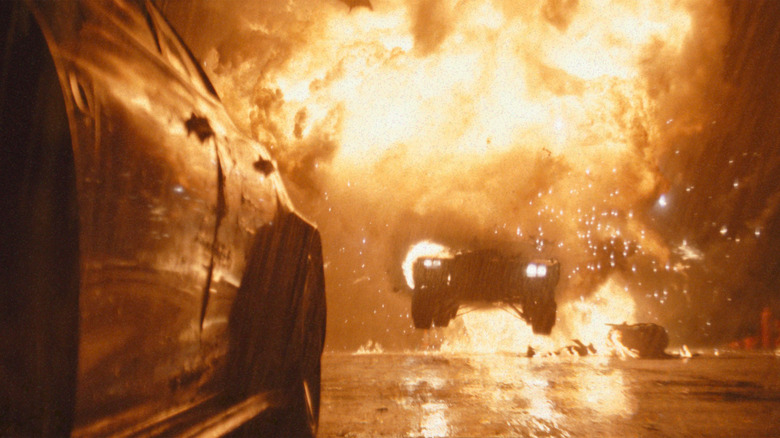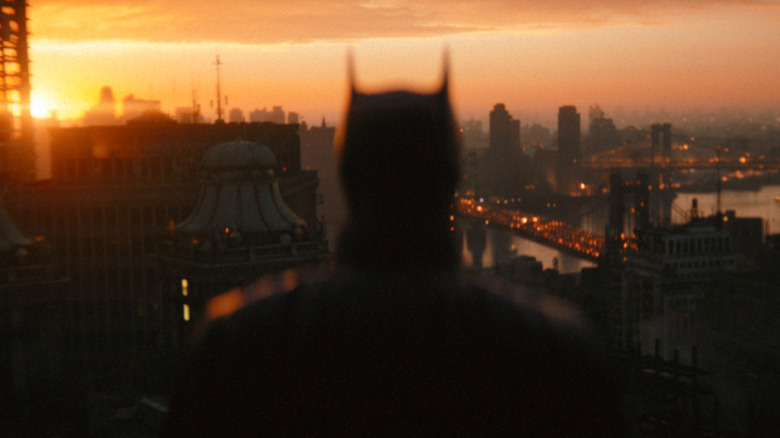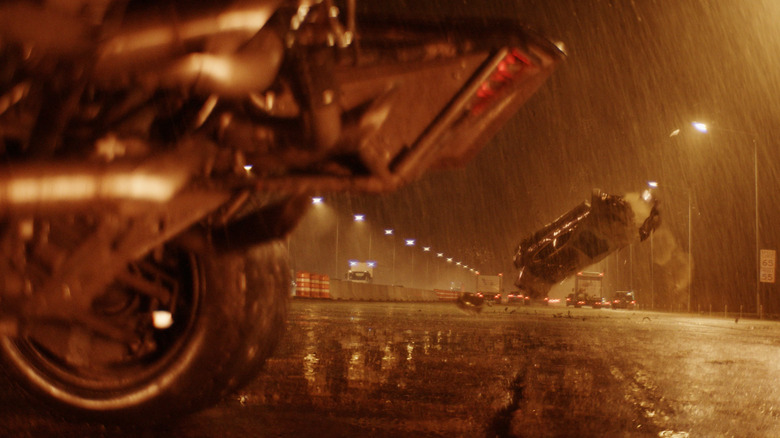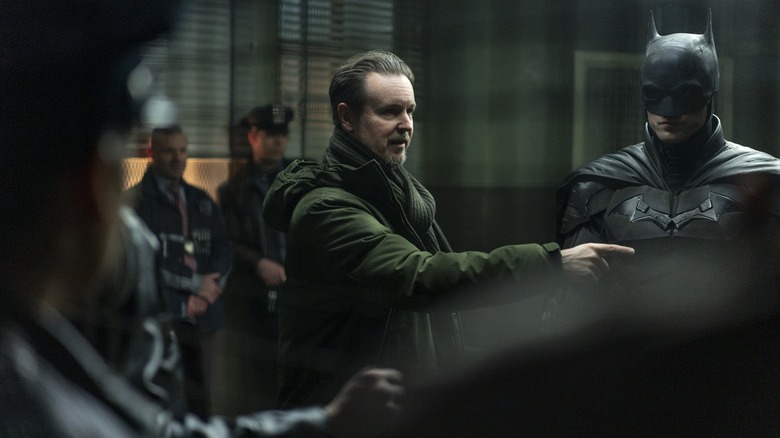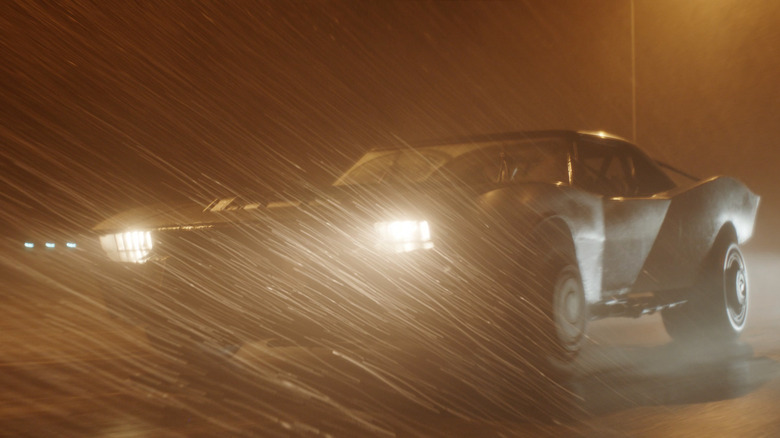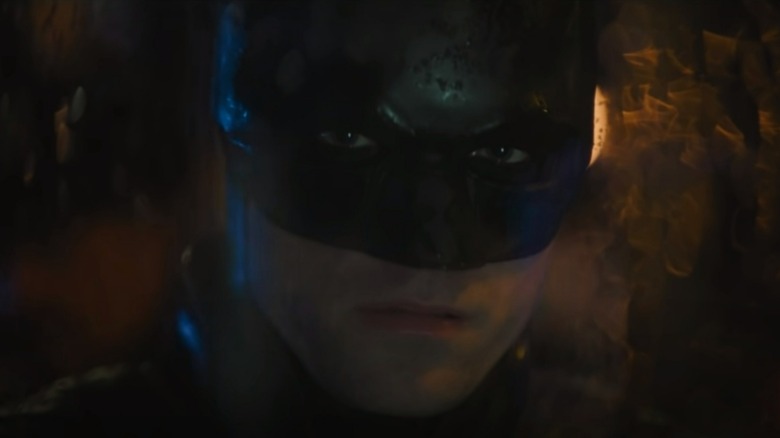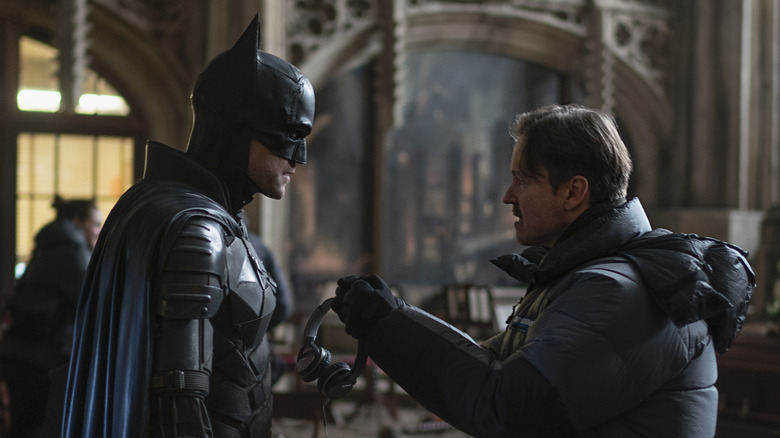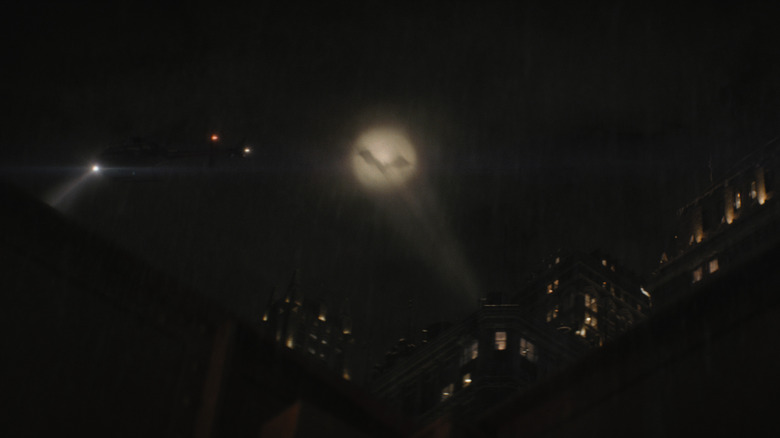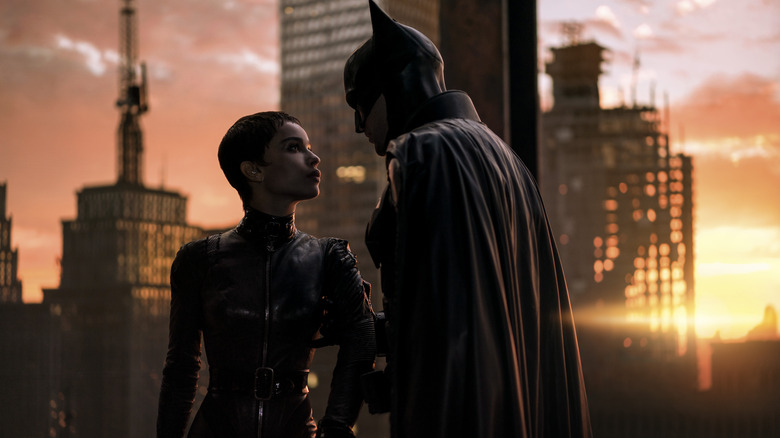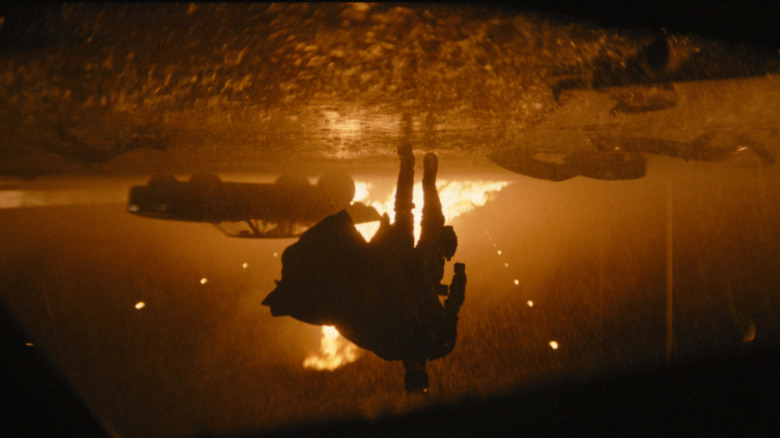The Batman VFX Supervisor On Crafting That Batmobile Chase, CGI Vs Practical, And More [Interview]
It can be incredibly tempting to watch an exceedingly well-made film — even a big-budget blockbuster about one of the most popular comic book characters of all time — and chalk up every aspect of it to a sole author. On one hand, viewers who have followed director Matt Reeves' career can tell just how successfully he infused "The Batman" with his distinctive filmmaking trademarks. Look no further than his similar approach to the latter two "Planet of the Apes" movies, with "War for the Planet of the Apes" specifically boasting many of the same Biblical-scale concerns that "The Batman" would eventually cover.
But as appealing as auteur theory can be, the truth is oftentimes much more complicated. Though a few significant individuals may receive the lion's share of credit in marketing and publicity, it truly takes an army spread throughout every level of the filmmaking process to bring a movie like "The Batman" across the finish line.
If that fact didn't already ring true simply by watching (the Oscar-winning) Greig Fraser's gorgeous cinematography, listening to Michael Giacchino's impeccable score, or gawking at production designer James Chinlund's hellish realization of Gotham City throughout the actual movie, it became abundantly clear during the course of my recent conversation with Visual Effects Supervisor Anders Langlands. The New Zealand-based VFX artist has a storied and widely respected legacy, having worked for Wētā FX — the groundbreaking VFX company that was founded by Peter Jackson and revolutionized the industry with "The Lord of the Rings" trilogy — on recent movies such as "Ad Astra," "Mulan," and "Zack Snyder's Justice League." All of that experience (and more) was put to the test in "The Batman," allowing Wētā to accomplish the impossible: Uniting us in near-universal praise over a modern superhero movie's excellent VFX work.
Now that the dust has settled after the initial release of "The Batman" in early March, I was able to pick Langlands' brain and talk about the value of his prior work with Matt Reeves on "Apes," the challenges of putting together the Batmobile chase sequence, the question of whether Stagecraft truly is "the next big thing," and even his thoughts on that never-ending "CGI vs practical effects" debate.
This interview has been edited for clarity and brevity.
'It really feels like a filmmaking company more than a visual effects company'
I remember watching "The Lord of the Rings" and all those behind-the-scenes breakdowns of everything Wētā contributed to it. I'm curious: Do you get the same sense of legacy, working with a company as genuinely historic as Wētā?
I definitely get a sense of the history and the legacy. Yeah. All our internal tools ... puns are named after [laughs] "The Lord of the Rings" quite often. It's really cool. I remember clearly first arriving there and particularly in Manuka Street, which was sort of the central office at the time. There's a whole bunch of props, you've got the [Witch King's] armor, just standing there in reception. You can't escape it down here at all. Even Wellington airport, when you first actually fly in, there's Gandalf riding a giant Eagle hovering over the arrivals lounge. So there's definitely a sense of that everywhere here.
What I really like about the company more than anything else is it really feels like a filmmaking company more than a visual effects company, if that makes any sense. It's much more steeped in that sort of approach than just being a boutique shop that has a bunch of people working on computers. It's more about a history of filmmaking and storytelling that definitely ties back to "Lord of the Rings" and that relationship between Wētā FX and Peter Jackson's legacy. That's definitely always hovering there in the background. And obviously, there's been so many huge achievements since then, particularly in character work, particularly the "Apes" trilogy, for instance, in terms of the work done there. That's constantly present as a bar to be aiming for, you know?
With "The Batman" specifically, it's not every day that a movie, especially a superhero movie, comes out and can unite almost everybody. And believe me, I spend a lot of time on Twitter [laughs], I know people don't usually react this way. Do you pay attention to that at all? Especially visual effects-wise, do you go out of your way to look for reactions?
I read — yeah, I guess is it being paranoid or vain? I'm not sure [laughs]. I tend to read when things come out just to see what people are saying about things. And particularly with the chase scene, it was nice that a lot of people reacted positively to that and thought it was an exciting part of the film. It's certainly a fun part to be involved with. I mean, with so many pictures that you work on, you don't really know until you actually see the final product whether it's actually going to be a good film or not ... in our side of the industry, you don't really have a huge amount of control over that. You can just have control of just trying to do your best work and make sure that you are contributing something positive to the whole picture.
So it's nice when people find what you've done exciting, and that's really the thrill of it, really. That's why film is such an exciting medium to be working in. It's the promise of millions of people seeing what you've created on the big screen, ideally.
'Quite a lot of it's actually fully digital, even though I think you probably wouldn't know from looking at some of the shots'
Can you speak to how much of the Batmobile chase was storyboarded and pre-vized beforehand, when you all first sat down to get started on that sequence?
That's an interesting one, because we came to that quite late. That was originally slated for someone else to do. And then they switched it around quite late while they were still shooting it, I think. So I know that they pre-vized the whole scene, basically to try and work everything out, and then going in with the intention and using that as a way to figure out how to shoot it. They went in and basically shot every shot. It's not like they pre-vized a whole bunch of stuff and then said, "Well, it's all going to be CG." They actually went and shot everything, even though there were some shots that we knew from the start would have to be digital because the camera couldn't safely do what they were after.
But that was all pre-vized ahead of time and then shot at Dunsfold Aerodrome in the UK. And then we did a bunch more work on that scene after it came back to us. So once they shot everything and Matt [Reeves] started cutting things together, we'd landed on a pretty rough assembly cut. And there were some things that weren't working in terms of storytelling, understanding how things were playing out. It's a very difficult scene to tell the story with, right, because Matt's vision for that was very much within the chase. We are always in the car with either Penguin or Batman or mounted on the side of a car or in a camera car that's actually on the road. We never cut to a wide master shot where we can clearly set the geography of the whole scene. It's very much like we are in it the whole time, which can make it quite difficult, storytelling-wise, if you're trying to help the audience understand where things are going.
So our animation team here, led by Dennis Yoo, did a bunch of post-viz, which is pre-viz on top of already-filmed material, to try and figure out a lot of these beats as far as, "How do the vehicles get from here to here? Why does that happen?" You know [laughs], "Why is this thing falling over all of a sudden?" "Well, it's because this thing crashed into that thing," and tracking all of that destruction across the whole scene.
We went through a whole bunch of iterations of that stuff, just roughing it out, redesigning some shots completely. I'm switching vehicles around with others. By the time we get into the tail end of the chase there, I think in the end, there's quite a lot of it's actually fully digital, even though I think you probably wouldn't know from looking at some of the shots. Just because it became easier for all the pieces that we were moving around, just to go fully digital rather than trying to hang onto the plate. There's a bunch of work there and just trying to get that story be coherent and make sure that it was telling what Matt wanted. Making sure that all of that logic worked through the chase was a huge part of what we were doing there.
'Matt [Reeves] tends to go for quite grounded, realistic, and quite naturalistic depictions of things'
So this obviously isn't the first time you've worked with Matt Reeves. I realize "The Batman" is very different from the motion capture-heavy work of "War for the Planet of the Apes." But when it came to "The Batman," how valuable was that prior experience with Matt?
Actually, it was pretty valuable, yeah. It's knowing the sorts of things that Matt cares about. Every filmmaker's got a different set of things that matters to them more than anything else, in terms of the things they pick up on and the way they want to tell stories. So having that understanding about the sorts of things Matt would like to do as opposed to somebody else is obviously hugely beneficial. Plus, Dan Lemmon, who is the overall Visual Effects Supervisor, has also worked with Matt several times on the "Apes" movies. So he and Matt have a common understanding. And I find that the way that Matt and Dan both tend to think about things aligns quite closely with the way that I like to think about things.
Matt tends to go for quite grounded, realistic, and quite naturalistic depictions of things in terms of lighting and stuff. And he's always searching for a logical reason for something to be the way that it is. He rarely does that sort of hand-wavy, "Oh, it's just a movie" kind of thing that some directors like to do. So going into that and having that past experience certainly helps, being able to concentrate on just elevating the work rather than spending several months at the start of a project trying to understand what exactly it is that the director's after and maybe fumbling around a little bit. With this, particularly with the shared history with Dan, we were able to hit the ground running very quickly, which is great because it was quite a compressed [post-production] schedule due to Covid delays and stuff. So having that prior experience was really invaluable in getting the thing completed.
'It's all the sum of prior experiences and life experience'
Looking back at the movies you've worked on, is VFX work sort of like any job where you bring your past experiences, the things you've learned before, and then that helps you with your current projects?
Yeah, definitely. It's all the sum of prior experiences and life experience as well, as much as anything else. Filmmaking's really about storytelling, right? It's about communicating some kind of human experience to everybody watching the film. And obviously we play a very small part of that in the visual effects world, but I think the same things still apply. Even if you're doing stuff that we were doing on "Apes" and all the movies sort of in-between, there's always little bits, little threads that carry you through from one to the other in terms of common challenges we want to solve. Those are things that you deal with day in and day out, like how to composite things and how to understand tricks for trying to make things look like they were shot with a real camera lens and that sort of thing. That's sort of the meat and potatoes part of it.
One of the big things that we had to do for the [Batmobile] chase scene was adding rain into every shot. And that was something that we'd actually spent quite a lot of time thinking about on "War for the Planet of the Apes." So I was handling the first chunk of that movie where it was just raining constantly at the start of the film. And of course there's a big waterfall as well. So we've done a lot of work trying to get the look of that stuff right.
Didn't quite get there, to my preference. I think, in a lot of cases the first time around, we were able to take a lot of that experience and then move that over to what we were doing here. Even though that was about monkeys and this is about superheroes, there's still little pieces that you can bring across from one to the other. And it's really like any creative pursuit. It's all practice at the end of the day. It doesn't really matter what type of film you're doing, it's all using the same skillset in a lot of ways. Every iteration, you get better as a practitioner and hopefully bring that to keep on raising the bar in everything that you do.
'You get the actors' heads essentially sort of swimming in this impressionistic wall of defocus in the background'
Sort of on the other end spectrum, did you and your team have to come up with any new techniques on "The Batman" to solve any problems that maybe you didn't anticipate? Or were there any new things that you brought into this that you could see yourself using again with future movies down the line?
We did a bunch of iterative stuff. I don't think there was any dramatic, new technology that we debuted here, but it was certainly some big improvements in the way that we did a few things. One of which being the rain, which I was just talking about. We came up with a pretty neat solution for being able to represent all the complexities of the way that a raindrop moves and the light refracts through it in order to create those beautiful textured rain streaks you get when you light rain on a movie set. We put a lot of effort into making that look really nice and believable. That's something that we can definitely carry forward to doing on other ones as well.
We put a lot of effort as well into upgrading our tools for handling defocus effects, what we call our deep defocus tools. And Peter Hillman and Ben Morgan and Beck Veitch are compositing people working together very closely to upgrade what was capable with those, in terms of modeling the way that bokeh in the defocus reaches the image, change across the frames, as the aperture gets projected onto the edge of the frame and you get what's called optical vignetting. And particularly, Matt tends to shoot things wide open as much as possible. So you get, particularly with dialogue shots, you get the actors' heads essentially sort of swimming in this impressionistic wall of defocus in the background.
That was really critical for matching the photography and particularly with the rather crazy lenses that Greig [Fraser] was using ... again, those upgrades we made to those tools, to be able to address that properly, will certainly be carried forward into future projects as well.
'It's our job to communicate what the director's actually trying to get at'
For this next question, I won't ask you to name any names, but have you ever worked on a movie before with a director that you could tell wasn't familiar with VFX and kind of struggled with that aspect of it, and maybe didn't put you guys in the best spot to succeed?
[Laughs] Yes. I mean, yeah, totally. You come across directors who are doing it — "it" being a big visual effects picture — for the first time. All the time. There's directors who have done smaller indie things and are plucked from that by a big studio to do a huge superhero epic or something. It's relatively common. But it's your job really to guide them through it. It's our job to communicate what the director's actually trying to get at and figure out how to make that into something that we can put up on screen.
It's about, in those situations, figuring out what it is that they respond to and how you can present the work in a way that they can actually understand and give you good feedback. Because there's a very complex process going from when we first get plates turned over to actually getting the final image. There's so many different stages and so many different people working on things in between. And some directors, particularly those who are more experienced, are much more able to look at something that's heavily work in progress and understand what that's going to mean for the final image and be able to give you good notes at that stage. But even directors who are pretty experienced with it just can't, until they see the final thing rendered and then suddenly say, "Oh, actually, no, this isn't what I wanted at all." [Laughs]
You just have to change the way that you work and the way that you try and schedule things and give them an opportunity to tell you what they want early enough in the process that you can adapt to. You know, there's no use just sort of sticking to the way that you want to run things. And then six weeks from the end, they say, "No, this isn't what wanted at all." Saying, "Well, tough." [Laughs] No one's going to be happy with that. So you have to try and adapt the way that you work to every different filmmaker that you're working with. That's part of what makes it so exciting to do, right? The work is different in every project and the people that you're working with are different in every project. It never really gets "samey" and that's part of the attraction, I think.
'That put a lot of pressure on the back end of the schedule'
You mentioned before working during the pandemic and the different situations that this whole upheaval has caused with "The Batman." Specifically, how did that shake up things on your end? You've already been working from home, I assume.
Yeah. Well, no. Yes and no. [Laughs]
Okay. [Laughs]
So we first started talking to Dan [Lemmon] and to Warner Brothers about "The Batman" in mid-to-late 2019, I think, so before [the pandemic] kicked off. And I went over to the UK mid-December 2019, just to see. Dan had his visual effects team over, they were already all set up at [Warner Bros. Studios at] Leavesden, they were already shooting some stuff in pre-production. The plan was that then I'd go over for the portion of the shoot that was, at the time, tied to us, although that later changed. And I think March, obviously, that then changed because everything kicked off and everything stalled. They had to go on ice for a while and then come back in and do what everybody else is dealing with in terms of Covid safety on set, which was extremely important, but obviously slows everything way down when you're working.
That put a lot of pressure on the back end of the schedule. It was frustrating for me, personally, not being able to be there while they were shooting the stuff, because creatively, that's often the most satisfying part of the project. But also, it allows you to develop a shorthand, I guess, with people, because you understand all the decisions that have gone into shooting something the way that it is, rather than you get turned over a bunch of stuff at the end and go, "Well, why'd you do it like that? That makes no sense." [Laughs] Essentially, there's a very good reason why things were done that way. But obviously, because the release date was pushed back six months because of Covid in the first place, things were obviously pretty tight on the back end. So it became essential for us to make sure that we were just raring and ready to go as soon as the work came in, once they finished shooting it.
From our perspective, by the point that we actually really got stuck into it, we'd been working from home for like a year, I guess [laughs], by that point. And we're fully, fully versed in how to do that. And Wētā's team did a great job in getting everybody set up for that very quickly and it was actually a very, very smooth transition. I don't feel like it really affected us in terms of our productivity or our capability to collaborate with people. Certainly the delays to the schedule made things more difficult, but the process, I think, was pretty well set by that point.
'It certainly beats the hell out a green screen'
Stagecraft, that technology is sort of new and I know that's ILM's domain there, but with "The Batman," that's become an even bigger deal. From your perspective, how do you see that? Is that really the next big step in the VFX industry? Or is it kind of a tool like anything else, and it just kind of depends on the specific production?
Yeah. I think it's a tool like anything else. It's certainly a very useful one, [though] it comes with certain constraints in terms of obviously cost [laughs] to actually get the set up there and the types of shots that you can get with it. But in a lot of ways, it certainly beats the hell out a green screen, having a background that's actually the right color, so actors get roughly the right lighting on them. But yeah, it's a tool like any other and it's definitely the most exciting advance in terms of how we're shooting stuff nowadays, certainly in as long as I can remember — probably since we switched to digital instead of film. And it's going to be really cool to see how far people can push it in the future.
I guess we have bigger and bigger screens [laughs]. So we have whole walls of it, a huge hanger just completely covered in LEDs and we can actually get some real volume in that. That's kind of the only downside with it at the moment, because everything is quite small around the action, so you can kind of feel that in the lighting. I mean, it's still certainly better than green screen, for sure. But it'll be interesting to see where it goes in the future.
And certainly, as you know, Greig [Fraser]'s been a big proponent of it for a while and as more and more filmmakers get more versed in it, we'll start to see cool stuff coming out from it. And Wētā's special projects team is doing a bunch of stuff for stage and it's really cool to see some of the work they're doing. Everyone's putting a huge amount of weight behind it. It's just really cool to see the sorts of things that we can do with that technology now.
'It's such a pointless argument'
My final question for you is sort of a big one. On social media, there's a big CGI vs. practical effects debate and that's just never going to go away, I guess. From your perspective, have you thought about that issue? Does that register to you at all?
It's slightly annoying sometimes. I find it funny more than anything else, because I think a lot of the people who scream about that more than anybody else actually don't realize that a lot of the stuff that they're championing actually contains a lot of visual effects. There was a fantastic Twitter thread the other day where someone — the shot at the end of the chase where the POV of Penguin upside-down in the car and Batman's walking up with his cape blowing in the wind with a huge fireball behind him. [Laughs] Someone's like, "Oh, see! I had a behind-the-scenes photo." It probably would've been Rob Pattinson's stunt double, rather than Rob himself, just standing around in the rain, with the Batsuit on and it's taken from roughly the same perspective.
It's roughly the same shot, but he's like, "See? No visual effects!" [Laughs] And, of course, Batman's cape that was blowing so nicely in the wind was CG. Actually Batman himself, I think, was mostly CG because we were replacing part of him that was over the fire. So we now had to replace his body, in order for the flaring from the fire behind him to work correctly over the lens, as well as the traffic on the other side of the road and street lamps down the road, but those are relatively minor additions, really.
It's such a pointless argument. Films looking one way or another I don't think has so much to do with the tools as it does to how they're used and what the intention behind things is. And personally, I feel like finding the best blend point between doing things practically and doing things digitally gives you the best result, but there are hundreds of reasons why you go one way or the other. Time and money is often one of them, and things being just completely practical or not, or being safe for people to do. That's one of the huge things that digital techniques have allowed us to do, is do more ambitious shots more safely without putting people in harm's way, doing crazy stunts, or just getting the crew in harm's way, because we can do things digitally now.
I don't really pay much attention to those things anymore. I find it slightly amusing, it's whatever. It doesn't matter. We're all just trying to make the most compelling images that we can in service of a story. I tend to not really think about how other people perceive that as a debate. It's more just, do I feel like we contribute something cool to a cool film? And then that leaves me happy at the end of it. But yeah, it is kind of funny when people make these assertions without really actually understanding what they're looking at.
"The Batman" is in theaters now.
